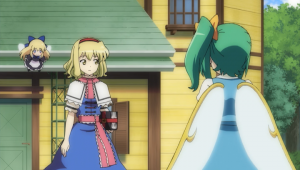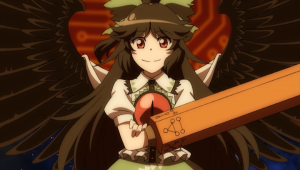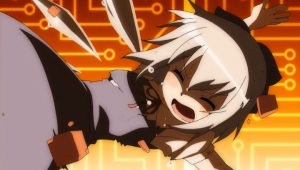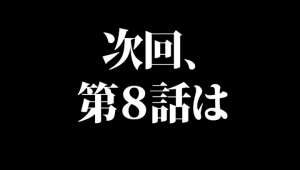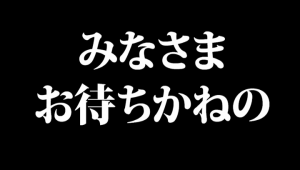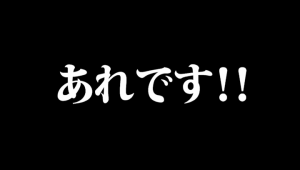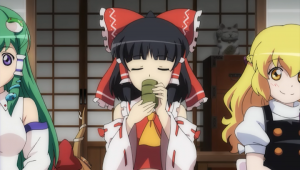What you’re about to read here is a work-in-progress article that I never bothered to finish because of my legendary laziness. In order not to hide it from viewers, I decided to post it. Please keep in mind it’s unfinished while reading. Also, if you’d like this to be completed, please let me know.
Edit, 18/09/2024: Also, this article reflects my state of mind when I wrote it. And you guessed it, my state of mind changed and evolved since (as always, I realize now that my words were pretty rubbish). Keep this in mind while reading.
The most exciting news this Comiket 92 was certainly the release of Touhou 16, Hidden Star in Four Seasons. But there was also something pretty exciting for those who happen to enjoy animation too, the release of second episode of The Sealed Esoteric History by Kyoto Fantasy Troupe. This episode boasts 41 minutes of animation, which makes it the longest Touhou derivated animated feature to date. But besides was also the release from a competing circle, Manpuku Jinja, of epsiode 9 of Fantasy Kaleidoscope. Within any sensible mind, it would naturally appear that Manpuku Jinja now has something to worry about. Indeed, with the recent PoFV and Hisotensoku arcs debacle, Manpuku is clearly not at its advantage, especially when the other circle managed to produce an excellent episode 1. But how things will turn out this time? Kyoto Fantasy Troupe is taking a long shot while Manpuku is finally finding a balance within their artistic decisions. So competition may be tougher than expected. And that’s what we’re going to study, step by step and find out if there is a winner at the end.
Packaging and presentation
Manpuku gives us a standard slim Amaray case containing the disc and a tiny booklet (or small art book) presenting all protagonists playing a big role during the arc. Inside the disc is a standard DVDISO structure with menus (with subs, without subs, or both in sequence, all without voice) and nothing else.
Fantasy Troupe gives us something that looks like a digipack containing the disc and a slightly bigger booklet or art book. On the disc itself, we have an single 1080p MKV file with two audio tracks and a subtitle one (Japanese only). No extra pictures this time unfortunately. However, we now have a DVDISO structure present on the disc too, which makes it playable on a hardware player now (the DVD Video part is PAL 720×576 with a single PCM audio track, for the curious).
So no winner on this round, as both presentations are pretty similar. The Amaray case vs. digipack aspect is only a matter of preference.
Price tag and cost
Manpuku’s strength? Well, let’s put things back in perspective again. While Manpuku’s disc is clearly cheaper, we also have less content. On the other side, the price tag of JPY3,500 was maintained despite the big duration. Even if we take both parts of The IN arc, we end up with JPY4,000 total (JPY2,000 per episode approx.) which clearly puts Fantasy Troupe at advantage here. So, Fantasy Troupe wins this round.
Storytelling and writing
We all know that’s Manpuku’s Achille heel. With their poor decisions and weird sense of priorities they managed to divide opinions among those who gave a chance to their animated works, and give us the impression that all that talent and skill was somewhat wasted because of that. Well, it looks like they’re trying to set the record straight this time. I’m happy to announce that the path they’ve taken since part 1 of the Imperishable Night arc is still maintained. Interesting things still happen all the time and the handling of time space shows less and less waste. There’s a good balance between relaxed moments and serious ones. The so-called fan service is now reduced to a minimum (and so are grimaces, only present during relevant segments). Will it be enough to face the other animated feature?
Now let’s talk about Fantasy Troupe’s case. I feared they would screw up because of the duration of their work. After watching, it is clear that on the other hand, this is one of their strength. But as I said, the bet was risky, as they in fact “cheated” a bit. Well, they “cheated” a lot. By “cheated”, I mean the story we have here is no longer connected to canon. While the story in itself is very nicely written, it’s getting a bit far from what we’d expect from a Touhou animation. For one, we have an original character to fill in the holes of ZUN’s universe and bases. For two, the tone shown here doesn’t let a place for action scenes or things like that. The story is more or less told through that original character who is supposed to be a relative to Sanae. While they did an excellent job at telling their own story despite the lack of elaborate animation (most time is spent within that relative’s shrine telling about her memories around a table, with Renko and Merry), some of you might be surprised and not like this approach. The problem with it, as some on /jp have pointed out, is that you could remove any Touhou reference it wouldn’t even be noticeable and would work on its own as an original story.
So for this round, we finally have an improvement from one side and a (well managed) risky bet on the other. This makes things even tougher. I’m going to make Fantasy Troupe win this one (by a very short margin) because they did manage not to screw up with such an audacious choice, unlike what I feared. Both animations were really pleasant to watch.
Character portrayal and personality building
This is, IMHO, Maikaze’s weakest poi… oh wait, this isn’t about Maikaze at all! ‘Scuse me. Well, in all honesty, this is also the category I’m feeling the least at ease to talk about because of my lack of knowledge about canon. One of the hottest debate on Touhou discussion places is how characters should be portrayed and sometimes how established canon can sometimes severely clash with one’s vision of the characters. Because of my ignorance to canon, I’m going to talk about the characters’ tempers and how tangible their personality feels, even if far from canon. When referring to Manpuku’s effort, opinions are mixed and multiple. There are people like me who think they do a good job and others who feel they’re far from what they should be like or behave. I genuinely think Manpuku has always been in the right direction, and this is even truer during this arc. I really like how Marisa reacts to Alice’s warnings in episode 9 for instance. This brings up background and depth to characters and I like that. Also, since their episodes have always been quite chatty, their characters always look like they have “interesting” things to say.
On the other side, since storytelling has always been their strong point, it is natural that their characters’ personalities also feel solid and tangible. This is what helps a characters being endearing and not being just a façade. I may have one grief with how they portrayed Renko and Merry in episode 2. They look rather childish and immature (and now it’s Fantasy Troupe’s turn to inaugurate a grimace feast), not the kind of behaviour you would expect from university students (okay, that makes them cuter and more irresistible but still) but again I’m not the right person to judge this.
Tie for this one. They both do a respectable jobs at trying to give those characters personality, unlike what I usually witness on another side from another competitor whose name begins by a “M”. I’m not the best person to talk about this particular area but I think both efforts look equivalent.
Overall tone and mood
One of the controversial aspect again in Manpuku’s effort. Everyone remembers when they first introduced their venerable and incredibly classy PVs back in 2009 or 2010, if I remember correctly. Fans were unanimous about them. I bet some of them even dreamt of a potential animated adaptation at that stage. Then came the aforementioned animated adaptation and bam! Everything collapsed. Well, hehe… no. I’m just exaggerating a bit. Still I remain a bit surprised to this day to the first reactions I saw when episode 1 just came out in summer 2011. So what could possibly have happened? Well, the classy PVs basically turned into a rather empty cartooney mess which barely managed to make itself look as classy and refined through the care put in visuals, animation and sound. Not exactly what one was expecting from such a rather ambitious initiative. And I did have my own fears when they announced they would make an animated series. Come on! They have no experience at all. A PV and an episode aren’t the same deal at all. It is clear they had absolutely no experience in making a longer animated feature. But, IMO, they managed pretty well. Chemistry worked fully and that particular ambiance of Touhou fanworks was still there. People’s reaction were (and are still) a bit overdone on the negative side but it did have a good impact in the end. But it took them a lot of time, efforts and episodes to finally find their feet. Despite the classy PVs, the tone remained light and rather childish, which somewhat clashes with the overall design. This is for me a rather failed attempt at catering the widest audience possible among Touhou fans interested in animation. We had to wait the Imperishable Night arc for the circle to find a good balance and get closer to what should be expected from an animated adaptation of that calibre.
For some reason, Kyoto Fantasy Troupe started with a clear advantage. They, from the beginning, gave the impression of knowing their topic. Everyone was pleasantly surprised to see that they didn’t mess up for their first attempt. Everything was spot on, either scenes with light mood, action scenes, serious scenes… Nothing cartooney or out of place. Then came this episode 2. Things are a bit different this time. They perhaps realized they did a bit too much on episode 1 and tried to lighten the tone. As a result it feels less classy, cheesier and more plain. Despite the quality of the story some of the attempts of easing the mood look a bit out of place now. Renko and Merry now offer us a grimace feast on their own. A few of the voices can sound pretty cheesy too (Suwako, Reimu and Marisa notably but they appearance is short so it’s not disturbing in the end). So the overall tone is this episode is definitely lighter and that may disappoint some of you.
Many of you would be tempted to give the point to Kyoto Fantasy Troupe this time because their efforts better match what fans would expect from a Touhou animation. But again, it’s not that easy. It’s not because Manpuku’s attempt looks like a cartooney mess from a distance that it actually is one. Fantasy Kaleidoscope also has the opportunity to shine thanks to its wonderful music and classy and epic battle scenes. So in the end, only episodes 5 to 7 deserve their share of negative criticism as they give no room for classy battles and characters begin to act like caricatures, just like in… oh well… that summer thing which takes a lifetime to produce as I suspect its circle to be rather careless. So I’m giving the point to Manpuku Jinja despite the missed efforts because they manage to be spot on during the arc they’re covering and because Kyoto Fantasy Troupe borrowed a few of Manpuku’s bad habits this time.
Overall aesthetics, visuals and animation
I saw a big increase in quality starting from the IN arc in Manpuku’s case. Did they take Fantasy Troupe’s previous effort as a reference? I don’t know. I like how they work their environments and still maintain the same quality of animation. Also, no more whoopsies since that arc. In Fantasy Troupe’s case, we now have a more traditional and plain looking (but also less disturbing perhaps) styling. Work is also palpable on environments but their animation looks only fine now, but not stellar. The fault lies with the fact that there is no action scene or something that would make the animation shine. However, Fantasy Troupe’s style still looks pleasing to the eye.
The winner for this round is Manpuku Jinja, as they still manage to amaze to this day. Animation is clearly their strong point. And now they have background work an par (if not superior) to Fantasy Troupe’s work.
Sound and music
Because of the different styling and narration choices, sound and music won’t have the same function in both animations. Strong and fitting BGMs are Manpuku’s main feature. In Fantasy Troupe’s case, BGM really serves as background music as it’s only here to support the narration. So it’s less memorable than in episode 1 (also the fact that voice plays a bigger role now makes a lot for that). Sound effects-wise, both are equivalent. Fantasy Troupe’s sound design no longer sounds cheap an care is really palpable.
Winner is Manpuku by a very short margin (more memorable BGMs) because Fantasy Troupe now have a very nice and pleasing sound design.
Authoring, visual and sound quality
Manpuku’s weakness until episode 4 where they managed to maintain the same acceptable visual quality despite the huge limitations of DVD video’s specs. The fact that they choose to author a true SD DVD Video even in 2017 is beginning to look outdated and hardly relevant. On the other side, Fantasy Troupe chooses to put a video file inside the disc, so that it won’t have the limitations of the format. So, they have an advantage here where they can offer a nice and pleasant 1080p image while in Manpuku’s case you’ll find yourself play around with waifu2x or nnedi3 to get a decent picture on a big TV set. Encoding-wise, both circles made the correct choices and we have variable bitrate for both. No more constant bitrate and bitstarving nonsense as there was on Sealed Esoteric episode 1.
Now sound-wise, while perceived quality is high on both attempts, Fantasy Troupe still uses lossy assets for their audio mixing projects. In order to guarantee the best quality you have to avoid using lossy assets (especially BGMs). Some more discriminating audiophiles might be able to pick up the quality loss. Manpuku, on the other hand still uses lossless assets, I’m pretty sure of that. Other non negligible detail, Manupuku decided to make their audio signal a bit hotter than usual, especially on busy action scenes (to give the impression of “epicness”, you know that “louder is better” meme) while Fantasy Troupe still maintained their low level in order to give room to the voices (also, OP and ED themes now have respectable volume). Both maintain a good level of headroom and have good dynamics. I wish Manpuku’s sound was 2dB quieter in this case however, as I often find myself reducing the volume of my HT receiver by 2dB while watching it.
I give the winning point to Fantasy Troupe this time, as their content is presented in HD, rather than the outdated DVD MPEG2 format. In other aspects, they’re pretty much equivalent.
Voice acting
Logically, the point would go to Fantasy Troupe, as it is full voice, right? Well, it’s not as simple. While the Chinese circle clearly has an advantage with its high grade cast (as opposed to somewhat dodgy fandubs you’re forced to seek out if you want voice on Fantasy Kaleidoscope), both approaches are completely different when it comes to “tell the story” and create an overall atmosphere. Manpuku manages to give that pleasing and entertaining experience without the use of any voice. While this can be disturbing on first watches, you get used to it as chemistry works perfectly. It’s so well put together to the point you tend to forget how “chatty” it is.
On the other hand, Fantasy Troupe relies on Sanae’s relative’s narration to convey the mood and tell the story. Also, voice seems to be better used in this episode 2 of Sealed Esoteric. But wait, it’s not over. There’s an extra audio track on Fantasy Troupe’s animation, with voices removed from the mix. Apparently, there was a demand for that, so they included it as a bonus (note that it’s only present on the supplied video file and not the additional DVDISO structure). However, unlike the first episode, it really feels empty without voices. All the mood is conveyed through Yayoi’s (oops, spoiler) narration and her voice actor does an excellent job. So all that is lost with the voiceless mix. However, it can work as a curiosity feature, if you want to listen the work done on sound effects, or if you really dislike having your 2hus talking. You can’t replicate Fantasy Kaleidoscope’s particular atmosphere just by removing the voices. Try listening to that additional audio track and you’ll quickly find yourself switching back to the full voice one. Clearly, full voice from the start was the best decision they made for that episode, as it suits its narration style completely. You might remember the things I said about “fanmade cachet”, etc. Well, we have to reconsider this, as Fantasy Troupe’s effort proves once for all that full voice can work wonderfully on a Touhou animation if done right (at a cost of a slight cheesiness). And I still insist on the “if done right” as it is very easy to screw up if done wrong.
So, who wins this time? I’m really tempted to give a tie on this one. Yes, really tempted. Because, Manpuku still manages to give us a wonderful experience without the use of any voice. On Fantasy Troupe’s side, the lack of voice becomes a weakness where it remain a strength (I’m maintaining it) on Manpuku’s one. But we have decent voice acting made by professionals on one side and dodgy voice acting through fandubs on the other if you want voice on both. So, I declare a tie for this round.
Cameos, fan-service, possible memes and other extras
Aaah… That aspect. Yeah, that aspect. It’s the one /jp people love to insist on when talking (often bad) about Fantasy Kaleidoscope. And with good reason. It was Manpuku’s featured bad habit since episode 1 of their series. They always felt forced for some reason to include (sometimes rubbish and annoying) references to fanon which were often either completely outdated or rather unfitting because of their overuse in other more or less exposed fanworks (hand-drawns, illustrations, fan videos, MADs, MMDs, etc.). The other speciality was the time and screen waste by imposed fan service scenes which have nothing to do with the story (everyone still remember that hot spring scene in episode 4 stealing focus to the battle between Marisa and Patchouli). I’m pleased to announce that those have been tamed down a lot since this arc. They even have the gut of mocking their (I hope) old bad habits during the Tewi segment. It may be unintentional but I appreciate how it turned out.
On Kyoto Fantasy Troupe’s side, all those things if there were any have always been introduced in a much subtle manner, and only through the shape of short cameos which are welcome and add some rewatch value. In my knowledge and unlike Manpuku Jinja, those never harmed the presentation of their episode or the story they’re trying to tell. However, things changed a little bit since episode 2. Creators now let it go a little more and offer us some rather borderline and evocative shots between Renko and Merry (that scene when they’re about to fall in a small pond for instance). It’s not flagrant and blatantly obvious but still.
Even if we have improvement from Manpuku Jinja, I’m still going to give the point to Kyoto Fantasy Troupe in this round as they always mastered that particular topic. By a small margin, but I’m making them win this round.
As said in the beginning, if you’d like this to be completed, please let me know. There are parts that may look incomplete or unfinished because I’m still adding things to this article.

